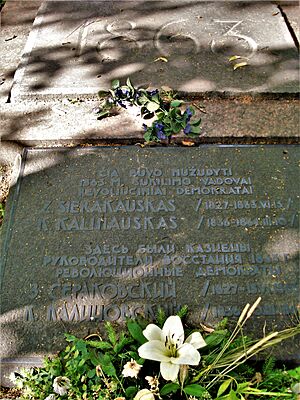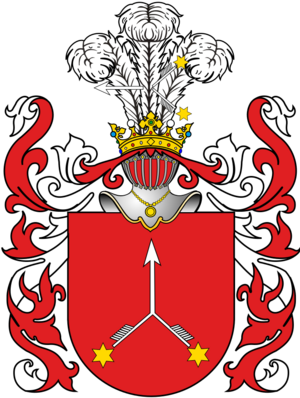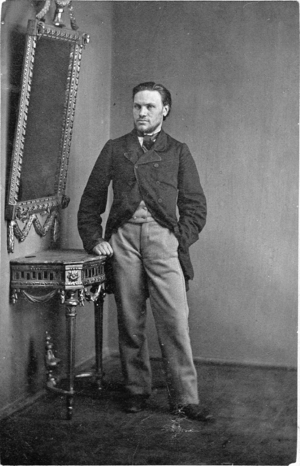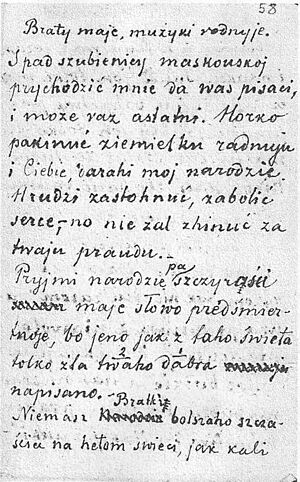Konstanty Kalinowski facts for kids
Konstanty Kalinowski (also known as Kastuś Kalinoŭski in Belarusian) was a Polish-Lithuanian writer, journalist, and revolutionary. He was born on February 2, 1838, and died on March 22, 1864. He played a very important role in the January Uprising of 1863. This was a big fight for freedom in the lands that were once part of the Polish–Lithuanian Commonwealth.
Today, Konstanty Kalinowski is seen as a national hero in Poland, Lithuania, and Belarus. In Belarus, many people consider him a symbol of their nation and a hero of Belarusian nationalism. Kalinowski worked to bring back a shared state for Lithuania, Ruthenia (which is now Belarus and Ukraine), and Poland. He wanted this new state to keep Polish culture and the traditions of the old Polish-Lithuanian Commonwealth.
Contents
Early Life and Education
Konstanty Kalinowski was born in Mostowlany, which was then part of the Russian Empire. Today, this place is in Poland. He came from a noble family called the Kalinowski family. This family was from the Polish region of Mazovia. His father, Szymon, managed a large farm and estate in Mostowlany.
Konstanty's older brother, Wiktor, became a historian. In 1849, Konstanty's father bought another farm near Svislach in what is now Belarus. Konstanty grew up there.
After finishing school in Svislach in 1855, Kalinowski briefly studied medicine at the University of Moscow. He then moved to St. Petersburg to join his brother and study law at the University of St. Petersburg. While there, he and his brother Victor joined secret groups of Polish students. These groups were led by people like Zygmunt Sierakowski. After graduating in 1860, Konstanty tried to get a job in the government in Vilnius, but he was not successful.
Revolutionary Work
Writing for Freedom
Konstanty Kalinowski returned to the Grodno area in 1861. There, he started publishing a newspaper called Mužyckaja prauda (which means Peasants' Truth). This was the first newspaper ever written in the Belarusian language. It was printed using the Latin alphabet. The first issue came out in June 1862. Peasants' Truth was published seven times until 1863. Kalinowski also published two other newspapers in Polish.
Kalinowski was part of a group called the Reds. This group wanted more democracy and included peasants, workers, and some religious leaders. They were different from the more moderate Whites.
In his writings, Kalinowski stressed that all people in the former Polish-Lithuanian Commonwealth needed to be free from Russia's control. He also wanted to protect and promote the Greek Catholic faith and the Belarusian language. He believed that peasants should join the fight for national freedom. Before him, this idea was mostly supported by the gentry (noble families). He liked the old traditions of the Polish-Lithuanian Commonwealth, such as democracy, tolerance, and freedom. He saw these as better than the national oppression caused by Imperial Russia.
He wrote:
While the Polish Council gives all fraternal peoples self-help, the Muscovite not only does so, but even where Poles, Lithuanians and Belarusians lived, he opens Muscovite schools, and in these schools they teach in Muscovite language, where you will never hear a word in Polish, in Lithuanian or in Belarusian, as the people want [...]
Some historians still discuss exactly which texts were written by Konstanty. Kalinowski was not happy with when and how the January Uprising started on January 23, 1863. He had some disagreements with other leaders of the uprising in Warsaw.
Leading the Uprising
After the January Uprising began, Kalinowski joined a secret group in Vilnius. Soon, he was made a special representative of the Polish National Government for the Grodno Governorate. His writings made him popular with both peasants and gentry. This helped the partisan groups he led grow quickly.
Because of his success, he was promoted. He became the main commander of all partisan groups fighting in the areas that were once part of the Grand Duchy of Lithuania. These areas are now in modern Lithuania, Belarus, eastern Poland, and Ukraine.

Capture and Execution
Despite some early victories against the Russian armies, the Russians sent a very large army of 120,000 soldiers to the area. The revolutionaries began to lose most of their battles. Sadly, Kalinowski was eventually betrayed by one of his own soldiers and captured by the Russians.
He was put in prison in Vilnius. While in prison, he wrote one of his most famous works, Letters from Beneath the Gallows. This was a powerful message to his fellow countrymen. He was tried by a military court for leading the revolt against Russia and was sentenced to death. On March 22, 1864, when he was only 26 years old, he was publicly executed by hanging in Lukiškės Square in Vilnius.
Kalinowski's body, along with others, was secretly buried by the Russian authorities. They buried him on a military fortress on top of Gediminas Hill in Vilnius. In 2017, his remains were found and identified. On November 22, 2019, his remains were formally reburied in the Rasos Cemetery.
Legacy
Konstanty Kalinowski's memory lives on in many ways. During protests in Belarus in 2006, people symbolically renamed October Square to Kalinovski Square. A documentary film about these events was also titled Kalinovski Square. In a famous book called King Stakh's Wild Hunt, one of the main characters has a portrait of Kalinowski above his desk.
More recently, during the conflict in Ukraine in 2022, Belarusian volunteers fighting for Ukraine formed a group called the Kastuś Kalinoŭski Battalion. This group later became a regiment.
In the city of Rivne in Ukraine, a street was named after Kalinowski. The Polish Government also has a scholarship program for Belarusian students who have been expelled from their studies. Since 2006, this program has been named the Konstanty Kalinowski Scholarship Program in his honor.
Images for kids
-
Monument in Mostowlany, Poland
See also
- Belarusian nationalism
- Belarusian national revival since the 19th century
- "Long Live Belarus!", patriotic slogan










